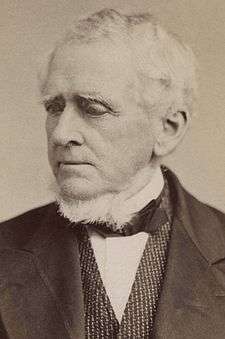John Adams Dix
| John Adams Dix | |
|---|---|
 | |
| 24th Governor of New York | |
|
In office January 1, 1873 – December 31, 1874 | |
| Lieutenant | John C. Robinson |
| Preceded by | John T. Hoffman |
| Succeeded by | Samuel J. Tilden |
| 24th United States Secretary of the Treasury | |
|
In office January 15, 1861 – March 6, 1861 | |
| President |
James Buchanan Abraham Lincoln |
| Preceded by | Philip Thomas |
| Succeeded by | Salmon P. Chase |
| United States Senator from New York | |
|
In office January 27, 1845 – March 3, 1849 | |
| Preceded by | Henry A. Foster |
| Succeeded by | William H. Seward |
| 16th Secretary of State of New York | |
|
In office January 15, 1833 – February 4, 1839 | |
| Preceded by | Azariah C. Flagg |
| Succeeded by | John C. Spencer |
| Personal details | |
| Born |
July 24, 1798 Boscawen, New Hampshire |
| Died |
April 21, 1879 (aged 80) New York City, New York |
| Political party | Democratic, Republican |
| Spouse(s) | Catherine Morgan Dix |
| Profession | Politician, Lawyer, Railroad President |
| Religion | Episcopalian |
| Signature |
|
| Military service | |
| Service/branch |
United States Army Union Army |
| Years of service | 1813–1828; 1861–1865 |
| Rank | Major General |
| Commands | Department of Virginia |
John Adams Dix (July 24, 1798 – April 21, 1879) was Secretary of the Treasury, Governor of New York and Union major general during the Civil War. He was notable for arresting the pro-Southern Maryland legislature, preventing that divided border state from seceding, and for arranging a system for prisoner exchange via the Dix-Hill cartel, concluded in partnership with Confederate Major General Daniel Harvey Hill.
Biography
Dix was born in Boscawen, New Hampshire, the son of Timothy Dix and Abigail Wilkins, and brother of composer Marion Dix Sullivan.[1] He joined the US Army as an ensign in May 1813, serving under his father. He attained the rank of captain in August 1825, and resigned from the Army in December 1828.[2]
In 1826, Dix married Catherine Morgan, the adopted daughter of Congressman John J. Morgan, who gave Dix a job overseeing his upstate New York land holdings in Cooperstown. Dix and his wife moved to Cooperstown in 1828, and he practiced law in addition to overseeing the land holdings. In 1830, he was appointed by Governor Enos T. Throop as Adjutant General of the New York State Militia, and moved to Albany, New York. He was Secretary of State of New York from 1833 to 1839, and a member of the New York State Assembly (Albany Co.) in 1842.
U.S. Senator

Dix was elected as a Democrat to the United States Senate to fill the vacancy caused by the resignation of Silas Wright, Jr., and held office from 1845 to 1849. In November 1848, he was the Barnburner/Free-Soil candidate for Governor of New York, but was defeated by Whig Hamilton Fish. In February 1849, he ran for re-election to the U.S. Senate as the Barnburners' candidate, but the Whig majority of the State Legislature elected William H. Seward.
Railroad president and postmaster
In 1853 Dix was president of the Mississippi and Missouri Railroad. He was appointed Postmaster of New York City and served from 1860 to 1861.
In addition to his military and public duties, Dix was the president of the Union Pacific from 1863 to 1868 during construction of the First Transcontinental Railroad. He was the figurehead for rail baron Thomas C. Durant, in both of his railroad presidencies. He was also briefly President of the Erie Railroad in 1872.
Civil War service
Dix was appointed United States Secretary of the Treasury by President James Buchanan in January 1861. At the outbreak of the Civil War, he sent a telegram to the Treasury agents in New Orleans ordering that: "If any one attempts to haul down the American flag, shoot him on the spot." Although the telegram was intercepted by Confederates, and was never delivered to the Treasury agents, the text found its way to the press, and Dix became one of the first heroes of the North during the Civil War. The saying is found on many Civil War tokens minted during the war, although the wording is slightly modified.
Major General
.jpg)
At the start of the American Civil War, Dix was appointed a major general in the New York Militia. He joined the Union Army as the highest ranking major general of volunteers during the war, effective May 16, 1861; also appointed on that day were Nathaniel P. Banks and Benjamin Franklin Butler, but Dix's name appeared first on the promotion list, meaning that he had seniority over all major generals of volunteers.[3] In the summer of 1861, he commanded the Department of Maryland and the Department of Pennsylvania. His importance at the beginning of the Civil War was in arresting and thereby preventing the Maryland legislature from meeting. This prevented Maryland from seceding, and earned him President Lincoln's gratitude. That winter, he commanded a regional organization known as "Dix's Command" within Maj. Gen. George B. McClellan's Department of the Potomac.[4] Dix commanded the Department of Virginia from June 1862 until July 1863, and the Department of the East from July 1863 until April 1865.
On July 22, 1862, Dix and Confederate Major General Daniel Harvey Hill concluded an agreement for the general exchange of prisoners between the Union and Confederate armies.[5] This agreement became known as the Dix-Hill Cartel. It established a scale of equivalents, where an officer would be exchanged for a fixed number of enlisted men, and also allowed for the parole of prisoners, who would undertake not to serve in a military capacity until officially exchanged. (The cartel worked well for a few months, but broke down when Confederates insisted on treating black prisoners as fugitive slaves and returning them to their previous owners.)
On October 10, 1862, Lincoln’s Secretary of the Navy, Gideon Welles wrote that “a scheme for permits, special favors, Treasury agents, and improper management” existed and was arranged by Treasury Secretary Salmon P. Chase for General John A. Dix. The motive of Chase appeared to be for political influence and not for financial gain.[6]
Dix was considered too old for field command. Some believe that his most distinguished contribution to the war was the suppression of the New York Draft Riots in July 1863, although the rioting had already subsided by the time he replaced General John E. Wool.[7] He was also active in the defense of Suffolk, which was part of his department. He served as the temporary chairman of the 1866 National Union Convention.
Later career
He was United States Minister to France from 1866 to 1869
He was Governor of New York from 1873 to 1874, elected on the Republican ticket in November 1872, but defeated for re-election by Samuel J. Tilden in November 1874. He suffered another defeat when he ran for the Mayor of New York City in 1876.
Death
Dix died in New York City and was buried at the Trinity Church Cemetery.
Legacy
- His memoirs, contained in two volumes, were compiled by his son.[8]
- Fort Dix, New Jersey, a United States Army post, is named for Dix, as is Dix, Illinois, and also Dix Township, Ford County, Illinois, and several revenue cutters, John A. Dix.
- Dix Mountain, one of the Adirondack High Peaks, was named for him. The name was later extended to its entire range, and unofficially applied to neighboring High Peaks South Dix (soon to be renamed Carson Peak) and East Dix. The Forest Preserve management unit in which those peaks are located is the Dix Mountain Wilderness Area.
- There is a memorial to Dix at the Cathedral of All Saints (Albany, New York).
See also
Notes
- ↑ McCaskey,John Piersol, Franklin Square Song Collection: Two Hundred Favorite Songs, Volume 5, retrieved 27 June 2014
- ↑ Historical Register & Dictionary of the US Army
- ↑ Eicher, p.773.
- ↑ Eicher, pp. 210-11.
- ↑ From Dix's report to Union Secretary of War E. Stanton, July 23, 1862, Official Records, Series II, Vol. 4, pp. 265-68.
- ↑ pp. 166, 175, 177, 227, 318, Welles, Gideon. Diary of Gideon Welles, Secretary of the Navy Under Lincoln and Johnson, Vol. I, 1861 – March 30, 1864. (Boston and New York: Houghton Mifflin Company, 1911.
- ↑ Warner, p. 126.
- ↑ Dix, Morgan. "Memoirs of John Adams Dix," Volumes 1 and 2 (1883, Harper & Brothers).
References
Secondary sources
- Eicher, John H., and Eicher, David J., Civil War High Commands, Stanford University Press, 2001, ISBN 0-8047-3641-3.
- Union Pacific Railroad, UP - History of the UP logo. Retrieved June 8, 2005. Timeline that also includes UP presidency successions.
- Warner, Ezra J., Generals in Blue: Lives of the Union Commanders, Louisiana State University Press, 1964, ISBN 0-8071-0822-7.
Primary sources
- Dix, Morgan (compiler). Memoirs of John Adams Dix, (1883). Vol. I Vol. II
- Dix, John Adams. Speeches and Occasional Addresses. Volume II (1864) online edition
- U.S. War Department, The War of the Rebellion: a Compilation of the Official Records of the Union and Confederate Armies, U.S. Government Printing Office, 1880–1901.
External links
- John Adams Dix at Find a Grave
- Likenesses of New Hampshire War Heroes & Personages
- Spartacus Educational: John A. Dix
- Mr. Lincoln and New York: John A. Dix
- John A. Dix at NNDB
| Wikimedia Commons has media related to John Adams Dix. |
| Political offices | ||
|---|---|---|
| Preceded by Azariah C. Flagg |
Secretary of State of New York 1833–1839 |
Succeeded by John C. Spencer |
| Preceded by Philip Thomas |
U.S. Secretary of the Treasury Served under: James Buchanan 1861 |
Succeeded by Salmon P. Chase |
| Preceded by John T. Hoffman |
Governor of New York 1873–1874 |
Succeeded by Samuel J. Tilden |
| United States Senate | ||
| Preceded by Henry A. Foster |
U.S. Senator (Class 3) from New York 1845–1849 Served alongside: Daniel S. Dickinson |
Succeeded by William H. Seward |
| Business positions | ||
| Preceded by William Butler Ogden |
President of Union Pacific Railroad 1863–1865 |
Succeeded by Oliver Ames, Jr. |
| Preceded by Jay Gould |
President of Erie Railroad 1872 |
Succeeded by Peter H. Watson |
| Diplomatic posts | ||
| Preceded by John Bigelow |
U.S. Minister to France 1866–1869 |
Succeeded by Elihu B. Washburne |




